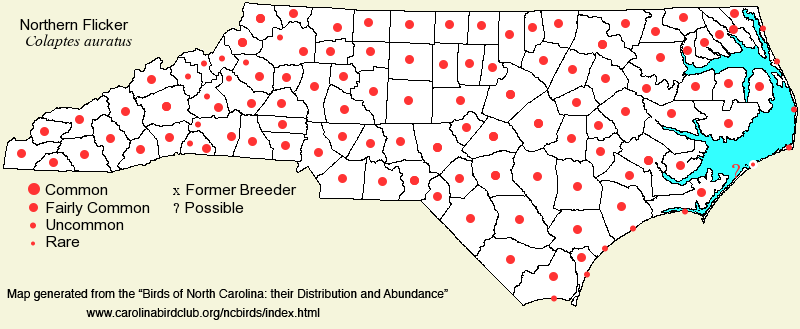 |  |
|
Northern Flicker - Colaptes auratus PICIDAE Members: | Search Common: Search Scientific: |
|
|
|||||||
| General Comments |
Of the eight species of woodpeckers in the state, only the Northern Flicker, Red-headed Woodpecker, and Yellow-bellied Sapsucker are considerably migratory. Though the Flicker might not seem obviously migratory in many areas of the state, as it remains numerous all year long, along the coast one can see noticeable movements southward in the fall, and birds may appear in places in winter where it is absent in the summer. In general, it tends to be more numerous in the state in winter than in summer, except in the middle and higher parts of the mountains. The Northern Flicker is one of the more familiar woodpeckers to backyard birders, as it often feeds on the ground on lawns, and drums on telephone poles or metal gutters. In the breeding season, Flickers occur in semi-wooded residential areas, parks, open woods, beaver ponds, and groves of trees in open country -- typically shunning deeper forests. Habitats in fall and winter are similar, though sizable numbers can often be seen in small areas, even in plowed fields, other croplands, and large lawns, as well as in swamps and other moderately forested habitats. NOTE: There are four state reports of "Red-shafted Flickers" (Colaptes auratus cafer), formerly considered as a valid species. All four are from coastal areas. | ||||||
| Breeding Status | Breeder | ||||||
| NC BRC List | Definitive | ||||||
| State Status | |||||||
| U.S. Status | |||||||
| State Rank | S5B,S5N | ||||||
| Global Rank | G5 | ||||||
| Coastal Plain | Permanent resident, with migratory movements. Over most of the region, generally fairly common in summer, and common at other seasons. Uncommon to fairly common along the Outer Banks and other barrier islands in summer, and fairly common to often common at other seasons; at times quite common in fall. Peak counts: ? | ||||||
| Piedmont | Permanent resident, with some migratory movements. Generally fairly common in summer, and fairly common to common at other seasons. At times, noticeable migratory movements seen in fall, but not as prominent as along the coast. Peak counts: ? | ||||||
| Mountains | Permanent resident, with some migratory movements, except very rare to absent at elevations above perhaps 5,000 feet in winter. Across the lower elevations, generally fairly common all year. At mid-elevations (3,500 feet to about 5,000 feet), fairly common as a breeder, but uncommon in winter; above 5,000 feet, uncommon as a breeder, and likely absent in the middle of winter. Peak counts: ? | ||||||
| Finding Tips |
The species is difficult to target, because it occurs as a widespread species in many habitats, yet is not overly common. However, general birding over a day usually produces a few birds, especially in towns with scattered trees and in semi-wooded residential areas. *** | ||||||
| Attribution | LeGrand[2023-03-22], LeGrand[2012-07-14], LeGrand[2011-12-10] | ||||||
| NC Map Map depicts all counties with a report (transient or resident) for the species. | Click on county for list of all known species. |
| NC Breeding Season Map Map depicts assumed breeding season abundance for the species. |  |